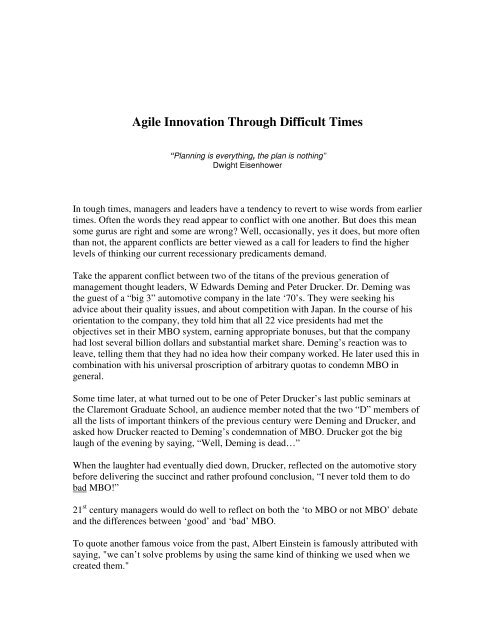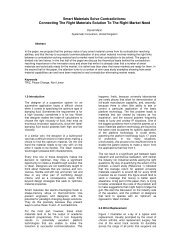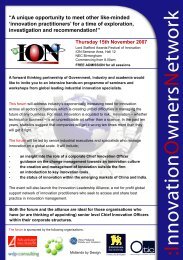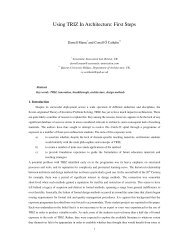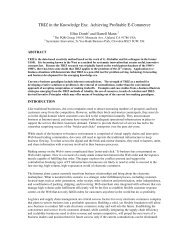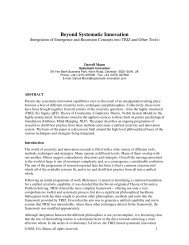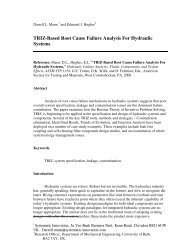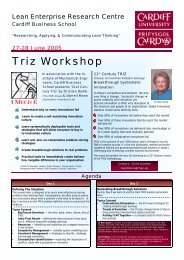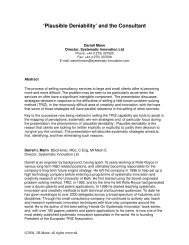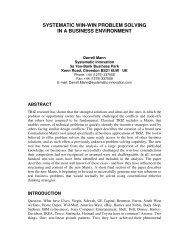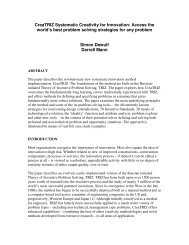Agile Innovation Through Difficult Times - Systematic Innovation
Agile Innovation Through Difficult Times - Systematic Innovation
Agile Innovation Through Difficult Times - Systematic Innovation
You also want an ePaper? Increase the reach of your titles
YUMPU automatically turns print PDFs into web optimized ePapers that Google loves.
<strong>Agile</strong> <strong>Innovation</strong> <strong>Through</strong> <strong>Difficult</strong> <strong>Times</strong><br />
“Planning is everything, the plan is nothing”<br />
Dwight Eisenhower<br />
In tough times, managers and leaders have a tendency to revert to wise words from earlier<br />
times. Often the words they read appear to conflict with one another. But does this mean<br />
some gurus are right and some are wrong? Well, occasionally, yes it does, but more often<br />
than not, the apparent conflicts are better viewed as a call for leaders to find the higher<br />
levels of thinking our current recessionary predicaments demand.<br />
Take the apparent conflict between two of the titans of the previous generation of<br />
management thought leaders, W Edwards Deming and Peter Drucker. Dr. Deming was<br />
the guest of a “big 3” automotive company in the late ‘70’s. They were seeking his<br />
advice about their quality issues, and about competition with Japan. In the course of his<br />
orientation to the company, they told him that all 22 vice presidents had met the<br />
objectives set in their MBO system, earning appropriate bonuses, but that the company<br />
had lost several billion dollars and substantial market share. Deming’s reaction was to<br />
leave, telling them that they had no idea how their company worked. He later used this in<br />
combination with his universal proscription of arbitrary quotas to condemn MBO in<br />
general.<br />
Some time later, at what turned out to be one of Peter Drucker’s last public seminars at<br />
the Claremont Graduate School, an audience member noted that the two “D” members of<br />
all the lists of important thinkers of the previous century were Deming and Drucker, and<br />
asked how Drucker reacted to Deming’s condemnation of MBO. Drucker got the big<br />
laugh of the evening by saying, “Well, Deming is dead…”<br />
When the laughter had eventually died down, Drucker, reflected on the automotive story<br />
before delivering the succinct and rather profound conclusion, “I never told them to do<br />
bad MBO!”<br />
21 st century managers would do well to reflect on both the ‘to MBO or not MBO’ debate<br />
and the differences between ‘good’ and ‘bad’ MBO.<br />
To quote another famous voice from the past, Albert Einstein is famously attributed with<br />
saying, "we can’t solve problems by using the same kind of thinking we used when we<br />
created them."
So, how do we rethink the MBO problem? We might perhaps start by trying to establish<br />
the difference between ‘good’ and ‘bad’. In the case of Deming’s prospective automotive<br />
client, ‘bad’ clearly meant that the objectives being set ended up being inappropriate.<br />
They were ‘good’ in the sense that generally speaking, it is good to have everyone in the<br />
organization know what they are there to do. One hopes, however, that when everyone’s<br />
objectives were set, they were correct. But, there are two ways that objectives can be<br />
wrong: either something happened between the period in which the objective was set and<br />
the results were measured, or the objectives of various divisions of the company were in<br />
conflict with each other. This would certainly be consistent with a lot of problems that<br />
seem to occur with MBO. Organisations, and indeed all of us, tend to set objectives with<br />
the implicit belief that we know what is good for the whole organization, and that nothing<br />
will change before the end arrives. If those assumptions were ever true, they certainly<br />
aren’t true in today’s speed-of-light global economy. The new problem, however, is that<br />
objectives get set at annual or quarterly or monthly reviews. We use fixed periods<br />
because they are easy to schedule and monitor.<br />
Just because something is easy to do doesn’t make it right. The fundamental flaw in<br />
calendar based planning is that if the world changes the day after we set the objectives for<br />
the next period, we spend the rest of the period doing the wrong thing. Which may, in<br />
worst case scenarios, mean almost a year’s worth of doing the wrong thing. Or two years.<br />
Or three.<br />
The more sensible strategy – especially, again, in a complex, rapidly changing world – is<br />
to put away the calendar and rather set objectives based on timescales set by the rate of<br />
change of the system within which the organization (or team) operates. In theory, the<br />
moment something changes which has any kind of impact on what we are doing, we<br />
ought to be reviewing and re-thinking whether our definition of ‘right’ has changed in<br />
any way.<br />
Whoa, wait a second. Let’s get this straight; the world is changing constantly, and we’re<br />
supposed to change direction every time we observe any kind of change? Well, yes.<br />
Fortunately, we have two things working for us to help overcome this apparently<br />
impossible dilemma. The first requires us to reflect on the story of the two men being<br />
chased across a snowy mountain by a wild bear? Part way along the chase, one of the<br />
guys stops to put on snow-shoes. The other guy shouts, ‘the bear is catching up, run’. The<br />
first guy shakes his head, ‘I don’t need to out-run the bear’, he says, ‘I only need to go<br />
faster than you’.<br />
Which is to say, that we don’t necessarily need to be sensing and responding every hour,<br />
we ‘merely’ need to be doing it faster and more effectively than our competitors.<br />
So much for theory, what might this ‘faster and more effectively’ look like in practice?
espond<br />
sense<br />
align<br />
interpret<br />
decide<br />
design<br />
Competitor sense-respond cycle time<br />
Our sense-respond cycle time<br />
‘Faster’ is the simpler of the two parts. It means cycling through the sense-and-respond<br />
loop more rapidly than your competitors. ‘More effective’ is more complex and, although<br />
there are many ways to cut a cake, appears to feature six essential activities:<br />
1) Sensing that something has changed in or around the system;<br />
2) Interpreting the significance and implications of such changes on the current<br />
system and objectives;<br />
3) Designing the appropriate response or responses;<br />
4) Making the decision about how to proceed<br />
5) Aligning the rest of the organization to act on the decision<br />
6) Successfully implementing the chosen response<br />
So much for the first part of the resolution of the perpetual change dilemma. What about<br />
the other half of the story?<br />
This side centres around the question of exactly what kinds of changes should the<br />
organization be sensing. As we’ve said already, change is constant. But some changes are<br />
more important than others. The really important ones – the ones that require<br />
organizations to do something – turn out to possess a very distinct characteristic: the<br />
changes to look out for are the ones that involve some kind of discontinuity or nonlinearity.<br />
Here are some of the main discontinuities that organizations need to be on the look-out<br />
for:<br />
- Step-change in current supporting technologies<br />
- Emergence of a new technology delivering the same functions as presently<br />
used technologies<br />
- Emergence of an apparently inferior disruptive technology<br />
- Merger or split between competitors or any part of the supply chain
- Departure from or arrival to an organization of a critical resource<br />
- Emergent conflict between relevant market trends<br />
- Generational shift in either customer or employee base<br />
- Change in legal regulations<br />
Having mapped what organizations need to be looking for when they are sensing the need<br />
to make a shift in their objectives, it now merely remains for us to work out the details of<br />
each of the activities in the sense-respond cycle. We can do that relatively simply by<br />
dividing the six basic activities into two clusters, sense-interpret-design and decide-alignrespond:<br />
Sense-Interpret-Design<br />
If the sense part of the story begins with the discovery of a discontinuity, the most<br />
effective way to proceed requires a toolkit capable of dealing with the conflicts and<br />
contradictions that inevitably arise from such discontinuities. The only sensible option in<br />
such situations is the Soviet-initiated, TRIZ methodology and its 21 st Century successor,<br />
<strong>Systematic</strong> <strong>Innovation</strong> (SI) methodology. Now based on the study of over three million<br />
discontinuity-resolution data-points observed across all forms of human endeavour, SI<br />
has successfully removed the noise from the contradiction-elimination story and thus<br />
allows organizations and individuals to interpret what is more important than what, how<br />
one discontinuity affects and potentially creates others, and most important of all, how<br />
the system needs to be re-designed or re-configured and how the local and global<br />
objectives need to be changed.<br />
In the light of the SI findings, ‘Sensing’ essentially boils down to, as mentioned earlier,<br />
‘finding the discontinuities’; Interpreting is all about understanding the inter-relationships<br />
between the different parts of the internal and external systems to be able to map the<br />
causal links between the discontinuities and the rest of the system; and Designing is all<br />
about resolving the conflicts and contradictions that these causal links create. That’s<br />
‘resolving’ as in creating step-change, contradiction-eliminating solutions. It very<br />
definitely does not mean ‘optimization’. We traditionally use the word ‘optimization’ to<br />
sound like it is a good thing. In some situations, indeed, it is precisely that. When making<br />
a response to a discontinuous shift, however, it is a highly inadequate response. Nonlinear<br />
shifts demand non-linear responses.<br />
In true Stephen Covey fashion, optimization is the right response in an incrementally<br />
changing world. Non-linear changes very often demand ‘wrong jungle’ responses. Which<br />
in turn may necessitate some significant rethink of the objectives passed on to the team.<br />
Decide-Align-Respond<br />
Once the team has designed a range of possible solutions to the initial discontinuity, the<br />
second half of the sense-respond cycle needs to be brought into play. If SI made for the<br />
best foundation for progressing the first half of the cycle, Hoshin Kanri is its ideal partner<br />
in arms for the second half.
The Hoshin Kanri method was developed initially by Professor Yoji Akao in Japan, and<br />
later was used world-wide as the strategic planning methodology associated with Total<br />
Quality Management. In many ways, Hoshin emerged from the resolution of the apparent<br />
conflict between management by objective (MBO), developed by Peter Drucker, and Dr.<br />
W. Edwards Deming’s 14 points, which specifically advised against using MBO.<br />
First, though, the Hoshin Kanri method is illustrated in the figure:<br />
Internal<br />
Factors<br />
External<br />
factors<br />
Strategic<br />
Plan<br />
Multi-year<br />
Create/<br />
Select the<br />
Hoshin<br />
Deploy<br />
the<br />
Hoshin<br />
Modify<br />
Planning<br />
System<br />
Do the<br />
Work<br />
Review<br />
Modify or<br />
Continue<br />
Modify Objectives<br />
Hoshin Kanri has two significant differences from classical MBO-style planning:<br />
1. There is an extensive process for translating each strategic objective (either<br />
annual or multi-year) into a set of plans for accomplishing the objective, with<br />
metrics for assessing the progress toward the objective, called “Deploy the<br />
Hoshin” in the diagram. In American-style Hoshin Kanri, a single objective is<br />
called “the Hoshin” and gets extensive development. In Japanese-style Hoshin<br />
Kanri, any number of “Hoshins” may be selected. Both use the term “catch-ball”<br />
to describe the give-and-take in the deployment process, a multi-level discussion
within the company (and sometimes with suppliers or customers) to decide what<br />
is to be done and how to do it.<br />
2. There is a 3-level review system. The objectives are changed if the results of the<br />
review indicate that the original objective was not valid, or has become invalid,<br />
either because of a change of external circumstances, or because of relationships<br />
between objectives that were not fully understood when the plan was constructed.<br />
The work plan for achieving the objectives is changed if the review shows that it<br />
is not effective. Finally, the planning system itself may be changed if the results<br />
of multiple reviews show that the objectives and the work plans are being<br />
changed frequently because the original plans were inappropriate.<br />
A recent example shows the power of the frequent reviews: A Texas city development<br />
board had set strategic goals of attracting German clean technology businesses to an<br />
unused military base that was being re-designed as a technology park. They did all the<br />
work that was planned—trade shows, publicity through the embassy and trade missions,<br />
tours featuring their cultural and educational advantages, etc. But, when the dollar/euro<br />
value changed substantially, there was nothing that this city could do to make their US<br />
location desirable. Because of the flexibility of their Hoshin review process, they re-set<br />
their goals to attracting a mix of business, targeted other world economies where the<br />
dollar still looked cheap, and used all the lessons learned in their German experiment to<br />
attract business from a variety of Asian countries.<br />
The Russian origins of TRIZ and the Japanese origins of Hoshin Kanri have been left<br />
behind by the companies that are using these methods. Combining the systematic,<br />
structured innovation of SI with the disciplined system of Hoshin Kanri gives companies<br />
the best of flexibility, accountability, asking the right questions and finding the strongest<br />
solutions. In the coming highly complex, highly inter-connected, highly non-linear<br />
‘continuous innovation’ global marketplace, only the agile will survive. According to our<br />
findings, the combination of SI and Hoshin offers companies the best chance to not just<br />
survive but also drive and thrive in this for-the-brave new world.<br />
© DL Mann 2008<br />
www.systematic-innovation.com


